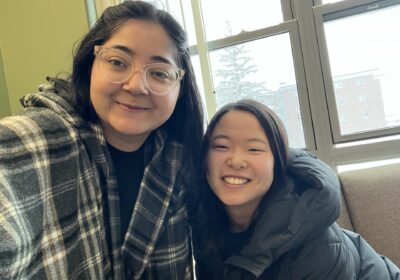An empowering interview done in his language
The other day I had an interview with Peruvian artist Persí Narváez, who is painting a mural for our beautiful campus. When I say interview, I realize that’s a bit of a stretch. Because it was the most unconventional interview I’ve ever had. Maybe that’s because it was entirely in Spanish, but I don’t think so.
He first showed up in my Spanish art class to share some of his works with us and answer our questions. I had no idea he would be there and I had just been assigned the story for The Spartan an hour before. So as he spoke to my class, while the others twiddled their thumbs and prayed to god they wouldn’t be called on to ask him a question in Spanish, I scribbled notes as fast as I could trying to capture everything he said.
Now, if you think taking lecture notes is hard, try having to hear what someone is saying in another language, translate it all in your head as he is speaking, and write that down before you miss the next important thing. No one would understand my notes expect me.
Part Spanish, part English, part shorthand.
I scheduled an interview with Narávez a few days later to see his mural and hear his message.
I didn’t know he didn’t speak English until we started talking.
He greeted me with a single kiss on the cheek and then I asked him my first question, in Spanish, which prompted him just start running. He told me about his mural, and had me help him bring over the five or six large canvases to the center of the mural so we could see everything together. He talked me through every single one and I was captivated. It was hard for me, don’t get me wrong. I was surrounded by so many distractions like Spanish music in the background, students speaking English together and some weird loud garage door in the FAC that kept opening and closing. I was sweating from the energy it took to focus on just him and understand his words.
Literally sweating.
I could tell he was so excited to share his work and what he is trying to communicate through art with someone who understood what he was saying. He lit up, laughing, smiling, pointing to certain parts of his work while he spoke about it. He doesn’t have a translator here like he has had in the past, so the people who actually understand what he is saying verbally are few.
But me, I was able to show him that I understood because of the years of Spanish classes I’ve taken. I am the only person who writes for the newspaper who would have been able to do the story. No one else could interview him. I was able to make him feel like he was heard and that what he was saying meant something to me.
And it did.
The message behind his art and the choices he makes when painting convey a message that resonates with me so intensely.
He talked about internal peace and confrontation and how people need to look inside themselves and decide what their purpose is instead of constantly looking outward at others with criticism and judgment. How when your body is aligned and you recognize yourself as important you will find happiness and all will fall into place.
This is something that I have been trying to work on. When he explained that was his message, I realized that I didn’t just understand his Spanish words, I understood what is most important to him; his art, and by extent, himself.
I still don’t know if he knows how much our conversation affected me. I didn’t have enough words in Spanish to explain to him just how much I relate to his art and how it changed me. It just makes me want to practice my Spanish even more.
It’s crazy how much an inability to communicate can change someone’s view of you as a person. How will they ever know who you are if they can’t understand when you tell them?
I’ll tell you how, and this is exactly how he inspires me. Narváez uses his art to show the world who he is and how he feels no matter what language they speak. Even though we couldn’t talk freely, and he can’t tell the Castleton community who he is, his art can. I understand why he paints.
And now, I get to use writing, journalism, and my understanding of Spanish to communicate his message to Castleton for him.
I can’t tell him how much I appreciate his work and what it means to me, but I can show him by writing these articles. I can show him by sharing his message with all of you. It is an absolute honor and I will never forget it.
– Carly Trombley






